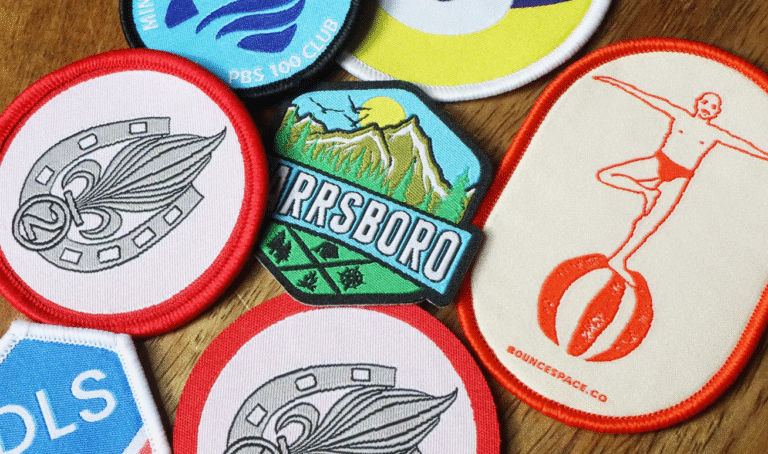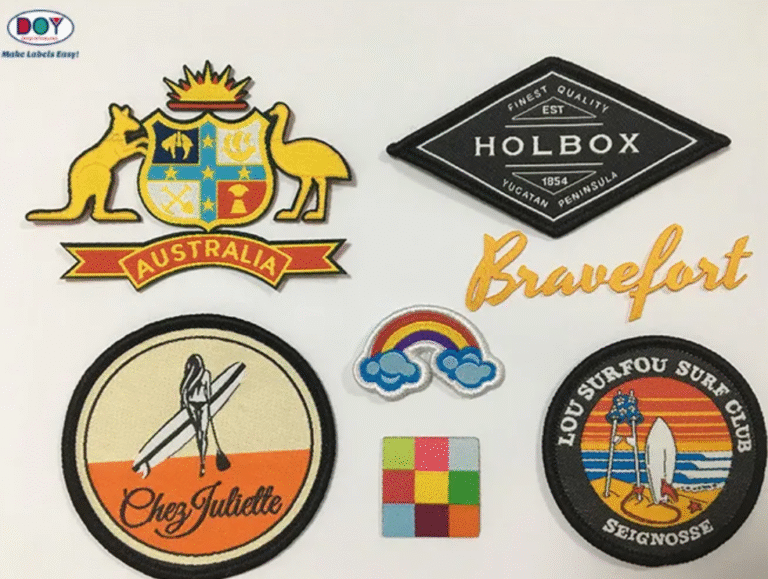You wanna design your own patch online . . . ! It is is a great way for people to show off their creativity, express themselves, and make things more personal. You may use them to embellish shirts, purses, caps, or any other fabric surface. Because you can modify these parts, you can create designs that are unique and express personal stories or brand identities.
With the rise of online platforms that make custom leather patch and other things, you can design your own patch online and design your own patch online no minimum in just minutes. Let’s see how you can easily make your creative ideas come to life!
Can Customized Patches Be Made at Home?
People who wish to add a personal touch may manufacture their own patches at home. With the correct equipment and resources, it’s straightforward to manufacture your own patches that showcase your flair.
- Things You Will Need to Design Your Own Patch online
Take out the necessary materials, including needlework thread, tools, and an iron, to begin. These simple tools can let you mend things in a variety of colors and forms. - Design Ideas
Think about sights or thoughts that make sense to you. To begin with, basic designs are preferable. You may draw inspiration from nature or from activities you wish to pursue. - How to Sew Things
If you don’t know how to sew with a machine, hand sewing is an excellent technique to put things together. Learn fundamental stitches, such as the backstitch and blanket stitch, to create clean, precise lines. - Iron On Adhesive:
- Using iron-on adhesive makes the procedure a lot simpler. You may easily place it on hats, coats, or bags using this method, even if you don’t know how to sew.
- Choices for personalization while designing your own patch online
You can add your own personal flair by wearing accessories like beads or feathers. This helps the patches look nicer and showcases your skill in making them.
How to Turn an Image into a Quality Patch
Transform photos, logos, or digital art into patch or custom patch without factories or bulk orders. To make a patch, first optimize your image. Test materials, then transfer the design with HTV vinyl or decals. Cut cleanly, seal for durability, and inspect for quality. It works for leather, PVC, or embroidered patches.
We have covered this steps into more details below. And, this beginner-friendly method works for leather, embroidered, or PVC patches. For this purpose,
Anyone Need These Tools
- Free Design Software: Inkscape (vector conversion) or Canva (simplification)
- Patch Material: 3-4 oz vegetable-tanned leather or heavyweight fabric
- Transfer Method: Iron-on HTV vinyl OR printable waterslide paper
- Cutting Tools: Precision scissors, craft knife, or Cricut machine
6 Steps for Flawless Image Conversion
- Optimize Your Image
- – Open the image in Inkscape. Use “Path > Trace Bitmap” to convert photos into clean vectors.
- – Simplify colors: Complex artwork rarely transfers well. Reduce to 2-3 dominant colors.
- – Critical Tip: Mirror text/logos! Images transfer reversed onto patches.
- Test Materials First
- – Print a test square on paper. Hold against leather/fabric to check size and clarity.
- – Dark materials need white HTV vinyl underlays. Natural leather shows laser burns easily.
- Choose Your Transfer Method
- – HTV Vinyl Method:
- Cut designs with Cricut on HTV vinyl
- Iron-on at 300°F (149°C) for 15 seconds with firm pressure
- – Waterslide Decals:
Print inverted images on waterslide paper
Soak in water 60 seconds, slide onto leather, seal with acrylic spray
- Cut Precisely
- – Leave 1/8″ border around designs if stitching edges
- – Use rotary cutters for curves, metal rulers for straight edges
- – Pro Trick: Freeze leather for 20 minutes for cleaner cuts
- Seal for Durability
- – Coat leather patches with Fiebing’s Resolene (gloss) or 50/50 beeswax/mineral oil (matte)
- – Heat-seal HTV transfers with Teflon sheet press for 5 seconds
- Quality Check & Fixes
- – Blurry edges? Re-vectorize at higher DPI (300 minimum)
- – Peeling vinyl? Lightly sand leather before application
- – Cracked decals? Apply 2 thin resin coats instead of one thick layer
Tips for Creating a Unique and Eye-Catching Patch Online With No Minimum
When designing a custom patch, creativity is key. A unique design will make your patch stand out and catch the eye of anyone who sees it.
- Choose Bold Colors
Vibrant colors can enhance visibility. Select hues that resonate with your brand or personal style to create a lasting and impactful impression. - Incorporate Unique Shapes
Think outside traditional shapes. Round, square, or even abstract forms can add flair and personality to your patch design. - Add Text Wisely
Use minimal text for maximum effect. Select fonts that are both legible and stylish to convey your message effectively without overwhelming the design. - Include Personal Elements
Integrate personal symbols or logos that represent you or your organization. This adds a layer of meaning and makes the patch more relatable. - Experiment with Texture Options
Different materials create varied textures, from custom patches to leather finishes. Mixing these elements can provide depth and intrigue in your final product.
Different Types of Patches and Their Uses
There are many distinct types of patches, each with a specific application. If you are familiar with the various types, you can choose the one that works best for you.
Patches with stitching
These pictures are meant to last and look nice for a long time. Good for clothes or daily use.
Patches That You Can Iron On
These patches adhere when heated and are easy to apply. An excellent technique to rapidly mend garments.
Weft Patches
Woven patches feature a more intricate design than stitched ones, as they are thin yet contain a great deal of detail. You may use it for logos and branding.
PVC patches
PVC patches are constructed of flexible plastic, allowing you to bend and seal them. Ideal for small items or instruments used outdoors.
Pieces of leather or Leather Patches
Leather patches add an elegant touch to hats and jackets while preserving their rustic character. Great for purchasing a lot of handcrafted leather patch caps.
You may wear each variety for fashion, to promote a cause, or simply for personal enjoyment.
How to Order Custom Patches and Pricing Options
Ordering custom patches is a straightforward process that can be done online in just a few clicks. Many companies like PatchVilla offer personalized patch services, allowing you to choose everything from size and shape to color and design.
These websites are built to be easy to use, even if you’re not great with computers. You’ll often find helpful step-by-step tools that guide you through the design process, including options like Free patch design template or a Patch design app. Whether you need one patch or one hundred, the process stays simple and clear.
Choosing Your Patch Type
Select the type of patch that best suits your needs. Options include embroidered, woven, or printed patches, each with its unique style and texture.
Designing Your Artwork
Upload your artwork or use an online tool to create your design. Ensure high-resolution images for optimal printing results.
Requesting Quotes
Most websites allow you to request quotes based on the quantity and complexity of your project. Comparisons help find affordable options while maintaining quality.
Understanding Pricing Structures
Familiarize yourself with pricing structures—costs typically vary by size, material, and intricacy of design. Bulk orders often come at discounted rates.
Finalizing Your Order
Once satisfied with your design and quote, place your order securely through the website’s checkout system for efficient processing.
Conclusion
A custom patch is more than just a decoration. It’s a way to tell your story. Whether you make your patch online or by hand, you are creating something special. You can display your name, occupation, hobbies, or group affiliation.
Patches help people feel proud with uniqueness. They help businesses grow. They make clothes and bags more fun. And they’re easy to make! Start small, be creative, and enjoy the process. Your patch can be simple or detailed. Either way, it’s yours—or that’s what makes it special. Let your patch speak for you!
Whether you use a Free patch design template, a Patch design app, or search for a Patch designer near me, remember—you can Design your own patch online free with Design your own patch online no minimum required.
FAQ
How can I make my own patches at home?
You may manufacture your own patches at home with some material, thread, adhesive, and basic sewing or ironing equipment.
How do I turn an image into a patch?
Use a free patch design template tool to add a photo and edit it so that it may be printed or stitched.
How to design a good patch?
Use bright colors, basic forms, distinctive accents, and text that is easy to read to design a good patch.




